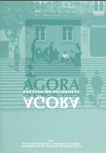El Realismo de Leyes Naturales: ¿en qué consiste?
Contenido principal del artículo
Resumen
Palabras clave:
Detalles del artículo
Referencias
Armstrong, D. (1983). What is a law of nature, Cambridge: Cambridge University Press. https://doi.org/10.1017/CBO9781139171700
https://doi.org/10.1017/CBO9781316499030
Berenstain, N., & Ladyman, J. (2012). “Ontic Structural Realism and Modality”. En: Elaine Landry & Dean Rickles (eds.), Structural Realism: Structure, Object and Causality. Springer. https://doi.org/10.1007/978-94-007-2579-9_8
Bird, A. (1998). “Laws of Nature”. En: John Sharid (ed.), Philosophy of Science: Fundamentals of Philosophy. UCL Press: Routledge, pp. 17-40. https://doi.org/10.4324/9780203165348
Bird, A. (2005a). “The Dispositionalist Conception of Laws”. Foundations of Science, 10, 353-370. https://doi.org/10.1007/s10699-004-5259-9
Bird, A. (2005b). “Laws and Essences”. Ratio, 18(4), 437-461. https://doi.org/10.1111/j.1467-9329.2005.00304.x
Bird, A. (2007). Laws and Properties, Oxford: Oxford University Press.
Carroll, J. (1994). “Appendix A: Nomic Platonism”. En: Laws of Nature. New York: Cambridge University Press, pp. 161-181. https://doi.org/10.1017/CBO9780511619908
https://doi.org/10.1017/CBO9780511619908.007
Chisholm, R. (1946). “The Contrary-to-Fact Conditional”, Mind, 55(220), 289-307. https://doi.org/10.1093/mind/LV.219.289
Chisholm, R. (1955). “Law Statements and Counterfactual Inference”, Analysis, 15(5), 97-105. https://doi.org/10.1093/analys/15.5.97
Dretske, F. (1977). “Laws of nature”. Philosophy of Science, 44(2), 248-268. https://doi.org/10.1086/288741
Friedman, M. (1974). “Explanation and Scientific Understanding”. Journal of Philosophy, 71(1), 5-19. https://doi.org/10.2307/2024924
Goodman, N., (1947). “The problem of counterfactuals conditionals” en Fact, Fiction and Forecast, Cambridge, Massachusetts, Harvard University Press, pp. 3-30. https://doi.org/10.2307/2019988
Hempel, C., & Oppenheim, P. (1948). “Studies in the Logic of Explanation”. Philosophy of Science, 15(2), 135-175. https://doi.org/10.1086/286983
Hume, D. (1902). “Of the Idea of Necessary Connexion”. En: L.A. Selby-Bigge (ed.), An Inquiry Concerning Human Understanding. Oxford: Oxford University.
Kistler, M. (2005). “Necessary Laws”. En: Jan Faye, Paul Needham, Uwe Scheffler & Max Urchs (ed.), Nature’s Principles. Springer, pp. 201-227. https://doi.org/10.1007/1-4020-3258-7_8
Kitcher, P. (1981). “Explanatory Unification”. Philosophy of Science, 48(4), 507-531. https://doi.org/10.1086/289019
Kripke, S. (1980). Naming and Necessity, Oxford: Basil Blackwell.
Lange, M. (2000). “The relation of laws to counterfactuals”. En Natural Laws in Scientific Practice. New York: Oxford University Press, pp. 42-94.
Lange, M. (2004). “A note on scientific essentialism, laws of nature, and counterfactual conditionals”. Australasian Journal of Philosophy, 82(2), 227-241. https://doi.org/10.1080/713659835
Lange, M. (2005). “Laws and their stability”. Synthese, 144(3), 415-432. https://doi.org/10.1007/s11229-005-5874-1
Lange, M. (2006). “Laws and Meta-Laws of Nature, Conservation Laws and Simmetries”. Studies in History and Philosophy of Modern Physics, 38(3), 457-481. https://doi.org/10.1016/j.shpsb.2006.08.003
Lange, M. (2009). Laws and Lawmakers, New York: Oxford University Press.
Laudan, L. (1981). “A Confutation of Convergent Realism”. Philosophy of Science, 48(1), 19-49. https://doi.org/10.1086/288975
Lewis, D. (1973). “An analysis of counterfactuals”. En Counterfactuals. Cambridge: Cambridge University Press, pp. 1-43.
Maudlin, T. (2007). “A modest proposal concerning laws, counterfactuals and explanations”. En The Metaphysics within Physics. Oxford: Oxford University Press, pp. 1-49. https://doi.org/10.1093/acprof:oso/9780199218219.003.0001
Mellor, D. H. (1974). “In defense of dispositions”. Philosophical Review, 83(2), 157-181. https://doi.org/10.2307/2184136
Mumford, S. (2004). “Natural necessitation relations” (pp. 83-104). En: Laws in Nature. Abingdon: Routledge. https://doi.org/10.4324/9780203458426_chapter_6
Putnam, H. (1975). Philosophical Papers, Vol. 1: Mathematics, Matter and Method, Cambridge: Cambridge University Press.
Stanford, P.K. (2006). Exceeding Our Grasp: science, history, and the problem of unconceived alternatives. New York: Oxford University Press. https://doi.org/10.1093/0195174089.001.0001
Salmon, W. (1984). Scientific Explanation and the Causal Structure of the World. Princeton University Press.
Tooley, M. (1977). “The Nature of Laws”. Canadian Journal of Philosophy, 7(4), 667-698. https://doi.org/10.1080/00455091.1977.10716190
van Fraassen, B. (1980). “Arguments concerning scientific realism”. En The Scientific Image. New York: Oxford University Press, pp. 6-40. https://doi.org/10.1093/0198244274.003.0002
van Fraassen, B. (1989). “Universals: Laws Grounded in Nature”. En Laws and Simmetry. Oxford: Oxford University Press, pp. 94-128. https://doi.org/10.1093/0198248601.003.0005
van Inwagen, P. (1979). “Laws and Counterfactuals”. Noûs, 13(4), 439-453. https://doi.org/10.2307/2215338






